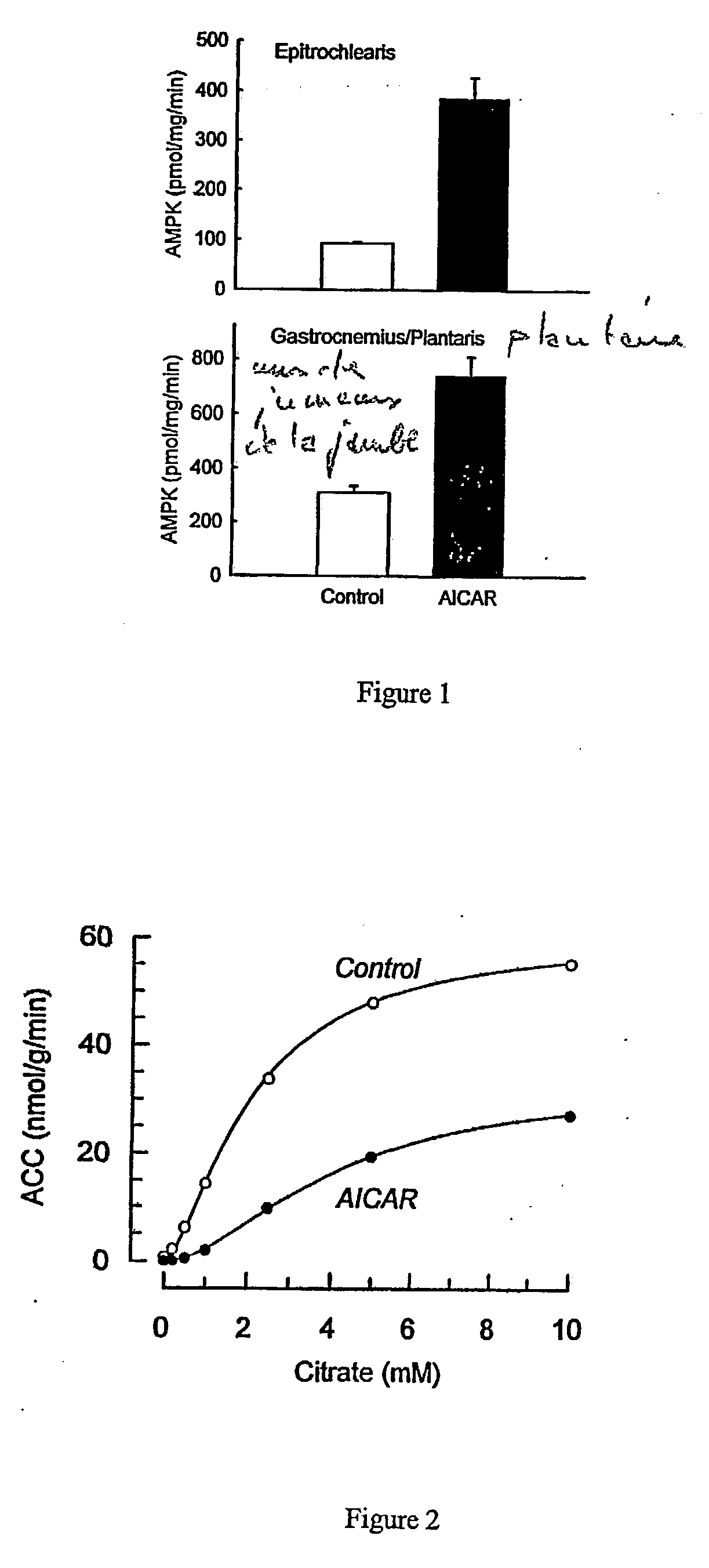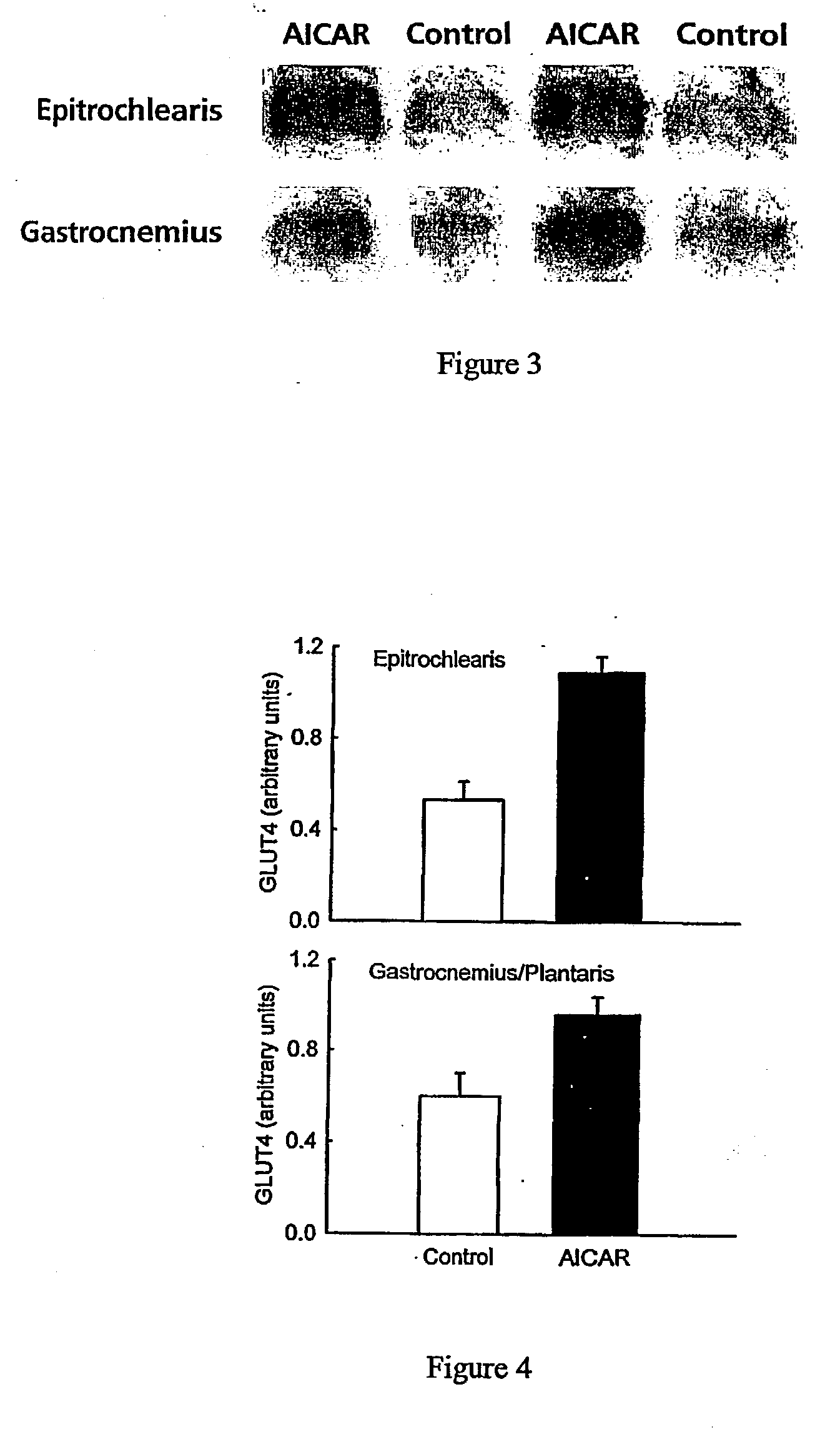Use of amp kinase activators for treatment type 2 diabetes and insulin resistance
a technology of amp kinase activator and insulin resistance, which is applied in the direction of carbohydrate active ingredients, biocide, animal husbandry, etc., can solve the problems of hyperglycemia and failure to trigger sufficient translocation/activation to allow normal glucose transpor
- Summary
- Abstract
- Description
- Claims
- Application Information
AI Technical Summary
Benefits of technology
Problems solved by technology
Method used
Image
Examples
example 1
[0055] Acute Injection of AICAR
[0056] All procedures were approved by the Institutional Animal Care and Use Committee. Male Sprague-Dawley rats weighing 197.+-.5 grams (Sasco, Wilmington, Mass. 01887) were housed in individual cages in a temperature (22-25 C.) and light-controlled (12:12-h light-dark cycle) room and were given food (Harlan Teklad rodent diet, Madison, Wis.) and water ad libitum. To determine acute in vivo effects of AICAR, a jugular catheter was installed and exteriorized on the back of the neck three days prior to the day of the experiment. This catheter was implanted for the purpose of allowing rapid anesthesia of the rat and rapid blood and tissue collection. Rats were then given AICAR (1 mg / g body weight) subcutaneously in sterile 0.9% NaCl or were given 0.9% NaCl (n=7 in each group). One hour following the subcutaneous injection of AICAR, rats were anesthetized by intravenous injection of pentobarbital (4.8 mg / 100 g body weight). The epitrochlearis and gastrocn...
example 2
[0064] Chronic Injection of AICAR
[0065] To determine the effect of chronic activation of AMPK, rats were injected (between 8 and 10 am.) subcutaneously with AICAR (1 mg / g body weight) or saline vehicle for five days in succession. This dose was shown in preliminary experiments to increase ZMP levels in the muscle to 0.57.+-.0.06 .mu.mol / g after 15 min, to 0.79.+-.0.06 .mu.mol / g after 60 min, to 0.69.+-.0.06 .mu.mol / g after 90 min, and to 0.60.+-.0.06 .mu.mol / g after 120 minutes (n=3 at each time point). Beginning with the first injection, controls were pair fed with AICAR-injected rats. Saline injected controls ate 17.+-.1 g and AICAR injected rats ate 18.+-.1 g of food during the 24 hour period prior to blood and tissue collection. Rats were anesthetized by intraperitoneal injection of pentobarbital (22-25 hrs following the last AICAR injection) and epitrochlearis, and gastrocnemius / plantaris muscles were collected and frozen as described above. Muscles were kept under liquid nitro...
PUM
| Property | Measurement | Unit |
|---|---|---|
| Dimensionless property | aaaaa | aaaaa |
| Electrical resistance | aaaaa | aaaaa |
| Body weight | aaaaa | aaaaa |
Abstract
Description
Claims
Application Information
 Login to View More
Login to View More - R&D
- Intellectual Property
- Life Sciences
- Materials
- Tech Scout
- Unparalleled Data Quality
- Higher Quality Content
- 60% Fewer Hallucinations
Browse by: Latest US Patents, China's latest patents, Technical Efficacy Thesaurus, Application Domain, Technology Topic, Popular Technical Reports.
© 2025 PatSnap. All rights reserved.Legal|Privacy policy|Modern Slavery Act Transparency Statement|Sitemap|About US| Contact US: help@patsnap.com



